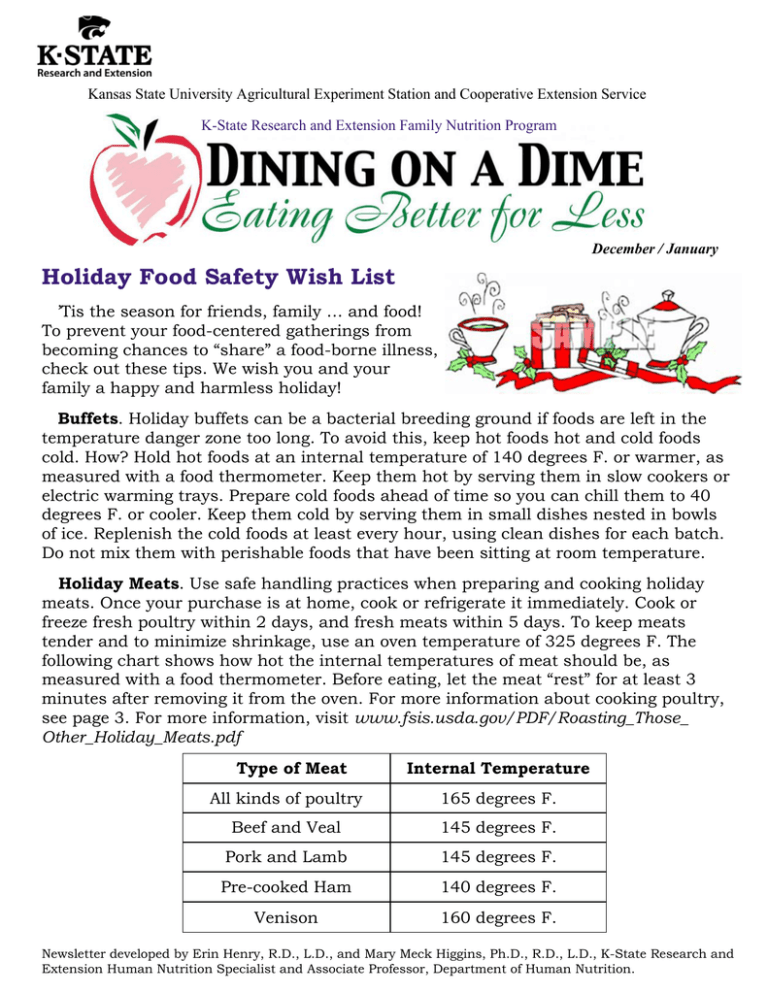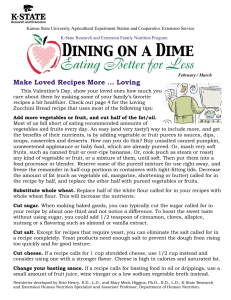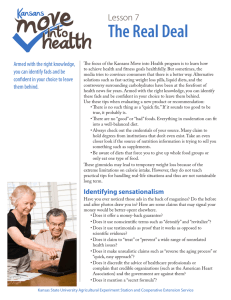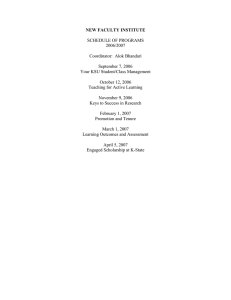Holiday Food Safety Wish List
advertisement

Kansas State University Agricultural Experiment Station and Cooperative Extension Service K-State Research and Extension Family Nutrition Program December / January Holiday Food Safety Wish List ’Tis the season for friends, family … and food! To prevent your food-centered gatherings from becoming chances to “share” a food-borne illness, check out these tips. We wish you and your family a happy and harmless holiday! Buffets. Holiday buffets can be a bacterial breeding ground if foods are left in the temperature danger zone too long. To avoid this, keep hot foods hot and cold foods cold. How? Hold hot foods at an internal temperature of 140 degrees F. or warmer, as measured with a food thermometer. Keep them hot by serving them in slow cookers or electric warming trays. Prepare cold foods ahead of time so you can chill them to 40 degrees F. or cooler. Keep them cold by serving them in small dishes nested in bowls of ice. Replenish the cold foods at least every hour, using clean dishes for each batch. Do not mix them with perishable foods that have been sitting at room temperature. Holiday Meats. Use safe handling practices when preparing and cooking holiday meats. Once your purchase is at home, cook or refrigerate it immediately. Cook or freeze fresh poultry within 2 days, and fresh meats within 5 days. To keep meats tender and to minimize shrinkage, use an oven temperature of 325 degrees F. The following chart shows how hot the internal temperatures of meat should be, as measured with a food thermometer. Before eating, let the meat “rest” for at least 3 minutes after removing it from the oven. For more information about cooking poultry, see page 3. For more information, visit www.fsis.usda.gov/PDF/Roasting_Those_ Other_Holiday_Meats.pdf Type of Meat Internal Temperature All kinds of poultry 165 degrees F. Beef and Veal 145 degrees F. Pork and Lamb 145 degrees F. Pre-cooked Ham 140 degrees F. Venison 160 degrees F. Newsletter developed by Erin Henry, R.D., L.D., and Mary Meck Higgins, Ph.D., R.D., L.D., K-State Research and Extension Human Nutrition Specialist and Associate Professor, Department of Human Nutrition. Page 2 Healthy Family Resolutions The New Year is a popular time to resolve to do something positive for your health during the upcoming year. This year, why not set a family resolution? Working together on your family’s resolution will offer support and a sense of being on a team. It will also help develop healthful habits in your kids in the year (and the years) to come! Here are some ideas for meal and physical activity resolutions: Prepare lots of meals at home. Involve your child in the kitchen with you. Depending on their ages, kids can set the table, rinse dirt from fresh fruits and vegetables, mix dry ingredients, make a cold salad, wash or dry dishes, cook a side dish, or even plan and cook balanced meals themselves complete with grocery lists. Also involve your child with shopping for food. Ask your children to help decide which fruits and vegetables to purchase, and teach about how to select highquality foods, identify good deals and read product labels. These are lessons that they will put to good use for the rest of their lives! See page 3 for some tasty menu ideas. Eat lots of meals together. Family meals can lead to stronger family bonds, better family communication, getting along better with others, and better grades; and less risk of substance abuse and of being overweight. You could resolve to increase the number of meals your family eats together this year, such as at weekday suppers, breakfasts, or weekend meals. Focus on enjoying the time spent around the table with your family members. Try to avoid doing other activities during family meals, such as watching TV, talking on the phone or texting. Watch less TV. Try limiting each family member’s television viewing to a maximum of two hours per day. Children currently watch about 30 hours of television a week, on average, according to the Nielson Company. That’s more than one-fourth of the hours they are awake. Too much TV is associated with obesity and worse school performance. Get fit as a family. If you and your family watch less television, you may want to use that extra time moving around being physically active. Some fun family activity ideas include snow-sledding, an outdoor game of catch or shooting hoops, footraces, jump roping, walks, bike rides, obstacle courses, dancing, and juggling with scarves or soft balls. The possibilities are endless! Keep a “family activity calendar” where you can draw a star on days when your child is active for 60 minutes or more. More ideas. Grow some herbs, plant a garden, eat more fruits and vegetables, eat more whole grains and fewer refined grains, limit fried foods, drink more water and unsweetened beverages, cut back on foods with added sugars or salt, and limit processed foods. Here is to your good health! You may view previous newsletters at www.ksre.ksu.edu/HumanNutrition/p.aspx?tabid=184 Contents of this publication may be reproduced for educational purposes. All other rights reserved. In each case, credit Page 3 Serve Up Savings , Deliciously Preparing more meals at home? Listed below are some tasty and budget-friendly menu options. Poultry. You typically can save money by purchasing whole chickens and turkeys, not pre-cut pieces. Chicken or turkey breasts in particular tend to be much more costly when purchased pre-cut. Before roasting the whole bird, if it is frozen let it thaw in a pan in the refrigerator. Take the giblets (neck, liver, gizzard and heart) out of the body cavity, discard the bag, and cook them with the bird. (Discard the liver if you don’t prefer its distinctive taste.) Place the bird, breast side up, in a baking pan. When the skin is browned, place a piece of aluminum foil loosely over the breast to prevent overcooking, then put it back in the oven until the internal temperature is 165 degrees F. Let the bird rest for 20 minutes before carving it. Be sure to keep the carcass (bones, skin, wings, back) after slicing the meat from the bones. Within 2 hours of cooking, cover and refrigerate leftovers. To watch a video on how to cut up a whole chicken or turkey, visit www.kraftrecipes.com/cooking-tips/ cooking-videos/how-cut-up-a-1141.aspx To make poultry broth to use in any recipe that requires chicken broth: Place the carcass into a large cooking pan, add chopped giblets and chopped vegetables (such as an onion, a carrot and several celery stalks), 2 teaspoons ground black pepper, and enough water to cover them. Put a lid on the pan and let it boil gently for 2 hours, then remove the bones. Freeze most of the broth in airtight containers in 1/2 cup portions, for future use. Add cooked rice or pasta to the remaining broth, giblets and vegetables and serve as soup. Fish. Canned tuna and salmon are tasty, versatile, economical and healthful foods. Make 5 fish patties by combining 14 ounces flaked fish with 1 egg, 1/3 cup oats, and 1/4 cup chopped onion, then cook them in a skillet. To get a recipe for Spicy Tuna and Apple Pockets, visit page 4 at www.ksre.ksu.edu/HumanNutrition/ doc11885.ashx To get a recipe for Fish Tacos, see page 4 at www.ksre.ksu.edu/ HumanNutrition/doc7352.ashx Vegetarian. Put the spotlight on plant protein foods for economical and healthful meals. To get a recipe for Cheese and Veggie Lasagna Casserole, visit page 4 at www.ksre.ksu.edu/HumanNutrition/doc7331.ashx To get a recipe for Black Bean Veggie Burgers, see page 4 at www.ksre.ksu.edu/HumanNutrition/doc13517.ashx Eggs. Eggs provide inexpensive high-quality protein for a quick meal at any time. Check out page 4 of this issue for an egg-based recipe called Spiced Veggies and Beans Quiche. To get a recipe for Egg Salad, visit page 4 at www.ksre.ksu.edu/ HumanNutrition/doc10563.ashx To get a recipe for French Toast, see page 2 at www.ksre.ksu.edu/HumanNutrition/doc11549.ashx For more information about healthy eating, contact your local extension office. This material was funded by USDA’s Supplemental Nutrition Assistance Program. The Food Assistance Program can help people of all ages with low income buy nutritious foods for a better diet. To find out more, call 1-888-369-4777. Dining on a Dime’s Cooks’ Corner Spiced Veggies and Beans Quiche (Makes 4 servings) Quiche is a French word that might as well mean “tasty,” but actually means a baked main dish pie that contains eggs and milk. This crustless recipe offers choices for the veggies and spices to use. Ingredients 1/2 cup finely chopped onion 4 eggs 1 cup shredded carrots OR chopped 2/3 cup fat-free milk green leafy vegetables of your choice 3/4 cup shredded 2/3 cup cooked pinto OR black beans mozzarella cheese 1 1/2 teaspoons curry OR chili powder Cooperative Extension Service Directions K-State Research and Extension 1. Spray a 9-inch round baking pan and a skillet with nonstick cooking spray. Heat oven to 300 degrees F. 2. Over medium heat, place the first 4 ingredients into the skillet and cook for 10 minutes, or until onions are softened. 3. Press vegetables into the baking pan. 4. Use a fork to beat eggs and milk in a bowl. Pour the mixture over the vegetables. 5. Bake for 25 minutes. 6. Top with cheese and bake for 15 more minutes, or until firm. 7. Serve hot. 8. Cover and K-State, County Extension Councils, refrigerate, or freeze, leftovers within two hours. Extension Districts, and the U.S. Depart- Nutrition Facts per serving: 210 calories, 9g fat, 4g saturated ment of Agriculture cooperating. fat, 0g trans fat, 200mg cholesterol, 250mg sodium, 16g carbohydrate, 4g dietary fiber and 16g protein. Daily Values: 100% K-State is an equal opportunity provider and employer. vitamin A, 6% vitamin C, 25% calcium, 10% iron.




